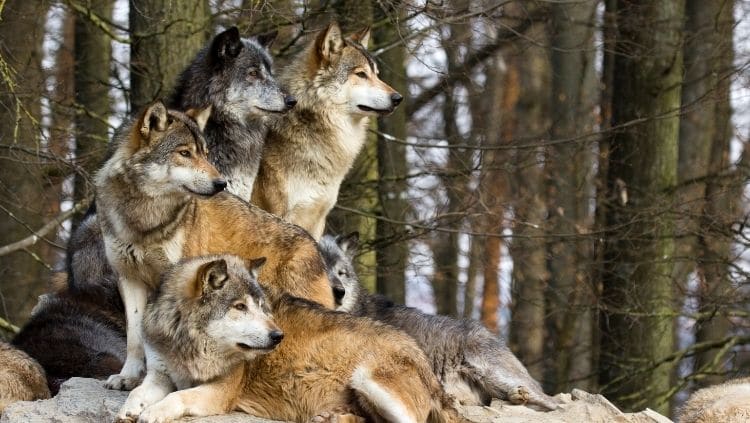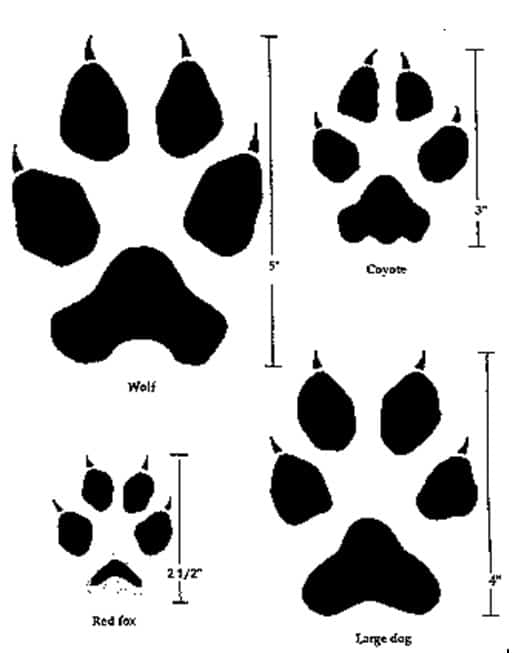How big are wolves? If you’ve never been up close and personal with a wolf, it’s tough to imagine just how large these canines are. While a distant relative of the domesticated dog, you’d be better off comparing them to their canid family members, coyotes, and jackals.
On average, a wolf measures about 2.8 ft (85 cm) in height and 5.2 ft (160 cm) in length. A mature male wolf typically weighs 100 pounds (45 kg) but can weigh more than 150 pounds.
What we commonly refer to as a wolf is typically a gray wolf (Canis lupus), which has numerous subspecies all over the world. To understand their size, you need to understand how they vary based on species, subspecies, and region.
How Big Do Real Wolves Get?
Before modern wolves, the largest ancestral canine competed with the likes of saber-tooth tigers. In the La Brea Tar Pits, thousands of dire wolf skeletons were found. From head to tail, they were about five feet long. It’s estimated that they weighed between 150 and 200 pounds or about 25% heavier than the largest modern wolves.
With such large ancestors, how big does a modern wolf get? When it comes to weight, you may see wolves that range in size from 40 to 170 pounds. Generally, wolves do not exceed 100 pounds, but it can happen.
How Big Is a Full-Size Wolf?
When judging how big a full-sized wolf is, you need to think about your region. Different sizes are common depending on the area of the globe.
North America
In North America, there are at least 24 subspecies of the gray wolf (Canis lupus). Then there also exists the rare and endangered red wolf (Canis rufus), a distinct wolf species.
The grey wolf’s range covers Yellowstone in Wyoming, western Montana, Alaska, northern Wisconsin, and northeast Oregon.
A northern gray can grow to be 30 inches tall and 100 pounds. In interior Alaska, an adult male weighs between 85 and 115 pounds. On the other hand, females weigh about 10 to 15 pounds less than the males. For a female to weigh more than 110 pounds is rare.
The Mexican grey wolf is the smallest subspecies in North America. It weighs between 50 and 80 pounds, stands about 28 to 32 inches at the shoulder, and is about the length of a German Shepherd. While Mexican grey wolves used to roam from central Mexico and throughout the southwestern US, the majority can be found in southeastern Arizona and southwestern New Mexico. Though more are being reintroduced in Mexico.
Europe and Asia
Europe is home to the Eurasian wolf. Eurasian wolves are a subspecies of grey wolves. Generally, Eurasian wolves are smaller than their North American relatives. They have shorter, denser fur, with sizes that vary based on region. The heaviest Eurasian Wolf recorded weighed 158 pounds. On average, males weigh about 70 to 130 pounds, whereas females are about 20% smaller.
When it comes to location, you can find them throughout Europe and Asia, including Scandinavia, Western Europe, Russia, Mongolia, China, and the Himalayan Mountains.
Africa
At one time, it was thought that there were no gray wolves in Africa. However, as of 2015, genetic findings revealed the golden jackal is a gray wolf. Now known as the African golden wolf, it can be found in North Africa and the Horn of Africa. Both males and females weigh between 15 and 33 pounds and stand about 40 cm in height.
How Big Is an Average Wolf?
So how big are wolves on average? It may be difficult to answer the question without considering various subspecies of gray wolves. After all, there is such a variation between different regions and species.
With the exception of the elusive red wolf, all the wolves listed below are some of the most common gray wolf subspecies. This is but a limited selection.
Arctic Wolf
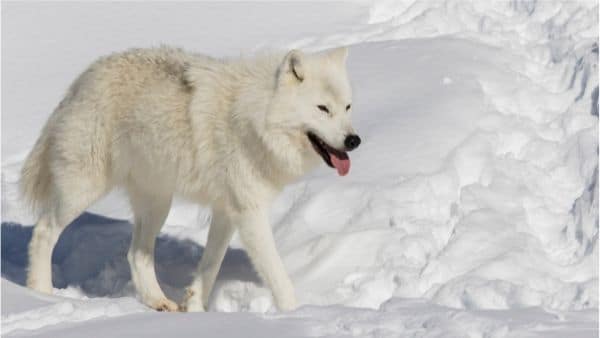
The Arctic gray wolf may also go by the name polar or white. They are found in the Arctic regions of Greenland and North America. When it comes to size, Arctic wolves range from 70 to 175 pounds, with a length of 3.2 to 5.9 feet.
Yukon Wolf

The Yukon wolf is a subspecies of the gray, also known as the Alaskan black or interior Alaskan wolf. They are bigger than most wolves and tend to have dark fur. With a thick undercoat to withstand the climate, they may be black with a mix of gray and brown coloring. An adult weighs between 100 and 120 pounds and may be between five and seven feet long.
Timber Wolf
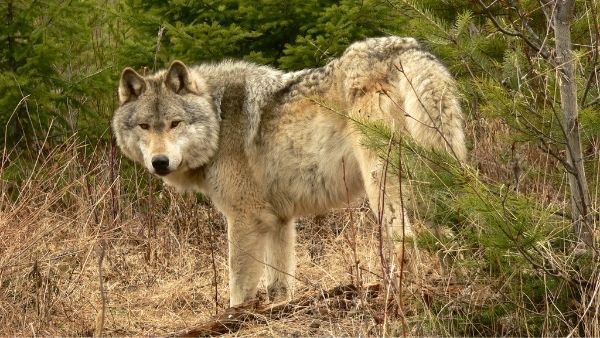
Timber wolves refer to a number of gray wolf subspecies that include Eastern, Northern Rocky Mountain, and Northwestern wolves. The Eastern is found in Minnesota, Wisconsin, and Michigan. Generally, they stand about 30 to 32 inches at the shoulder and weigh around 65 pounds. However, the Northern Rocky Mountain wolf stands about the same height but can range between 70 and 150 pounds. The Northwestern may weigh over 100 pounds.
Indian Wolf
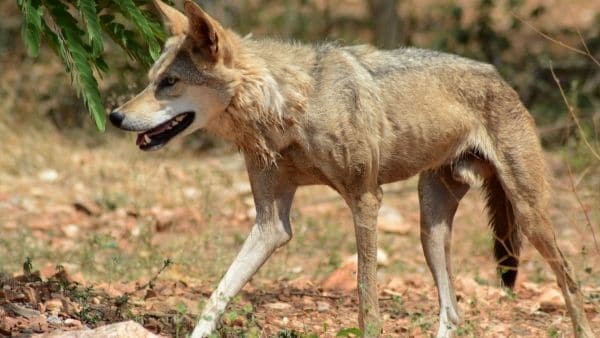
Indian wolves are on the small size for a gray wolf subspecies. They only measure about three feet in length, with the tail providing them with an extra 11 to 20 inches. When it comes to weight, they only reach about 55 pounds. Generally, the Indian can be found in west and South Asia.
Arabian Wolf
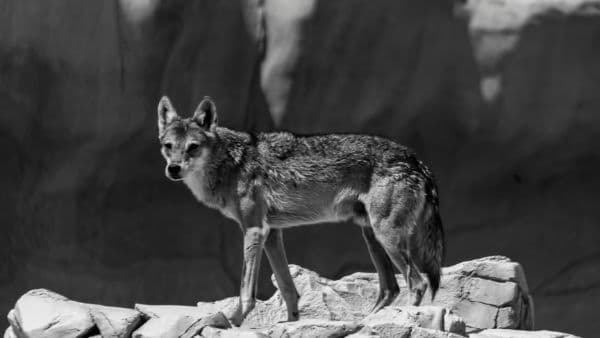
The Arabian wolf is one of the smallest of all gray wolves and adapted to the desert. While small for a wolf, it is one of the largest canids in Arabia. They are about 25 to 25 inches at the shoulder and weigh between 40 and 45 pounds. To survive in the desert, Arabian wolves need to be lean.
Red Wolf
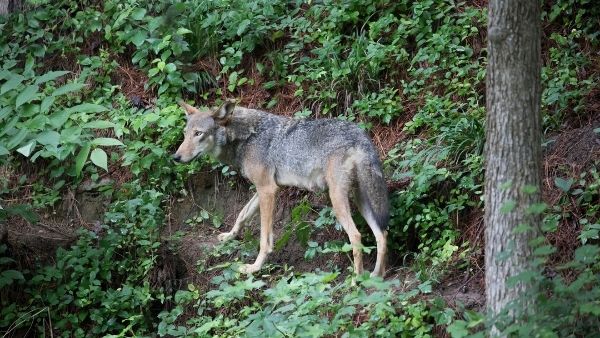
Red wolves are the most endangered of all wolves. They are only about four feet long from nose to tail and weigh between 45 and 80 pounds. While native to the Eastern and South Central United States, there are only a few wild ones in eastern North Carolina. As of late 2021, it was estimated that there were only about 15 to 17 in the wild, with 241 in captivity.
How Big Are Wolf Paws?
If you were to track a wolf, you would find that their paw tracks are much bigger than a dog’s or a coyote’s. A gray wolf, for instance, may have paws around five by four inches. There are four toes, all symmetrical, with large claws.
What Was the Largest Wolf Ever Recorded
The largest wolf documented in Alaska was 175 pounds. If you want to know where some of the biggest wolves are, you need to head to Alaska and Fortymile Country. In 1939, a legendary trapper and hunter named Frank Glaser caught the 175-pound canine.
Now, when it comes to the weight of the canid, their weight may fluctuate depending on when they ate. The 175-pound canid had a stomach full of meat when it was caught. Generally, a wolf may eat about 5 to 15 pounds of meat when it feeds in the winter.
If caribou or moose is available, the animal may eat about 20 pounds in one sitting. A wildlife biologist named Craig Gardner caught a 140-pound male in 1997. The male had an empty stomach. Similarly, in 2001, a male and female were caught, weighing 148 and 110 pounds respectively. The two had been on a recent moose kill.
What Is a Wolf’s Size Compared to Other Animals?
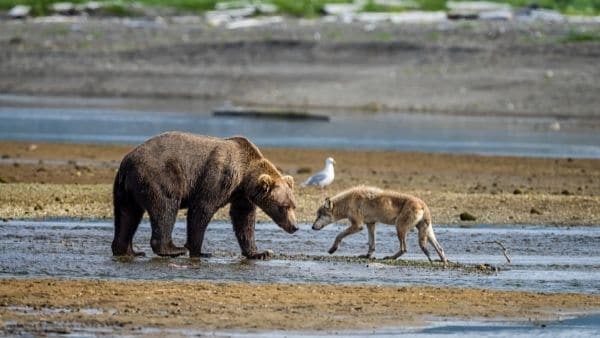
Have you ever wondered how big a wolf is compared to other animals or even yourself? When answering the question “how big are wolves,” the best way to picture it is through a wolf size comparison with humans and other wild animals.
Wolves vs. Humans
If you’re like most people, you probably haven’t been up close and personal with a wolf. If you were to meet an Arabian wolf, it may be a similar size to a large dog. It would come up to an average person’s knees. However, the larger wolves may come up to your waist, and if they stand on their hind legs, they may be able to balance their front paws on your shoulder.
Wolves vs. Mountain Lions
Mountain lions or cougars are bigger than wolves on average. It may be difficult to make a one-on-one comparison because the size of mountain lions and wolves varies based on their region. Mountain lions in Brazil, for example, may be smaller than gray wolves. Whereas Canadian mountain lions are larger.
The length of a male Canadian mountain lion is just over seven feet with an average weight of 156 pounds. A cougar from Brazil, however, is just over six feet long and weighs between 91 and 150 pounds.
Wolves vs. Coyotes
When viewing coyotes and wolves at a distance, you may have difficulty determining between a coyote and a wolf. The biggest difference between the two canines visually is that one is much larger than the other. A coyote only weighs between 20 and 50 pounds and appears much smaller. In addition, they have taller, pointed ears and a more narrow pointed nose.
Wolves vs. Bears
All species of bear are much bigger than wolves. Even the smallest bears, American black bears, weigh 200 to 600 pounds, compared to the largest wolves, whereas they are about five to six feet in length.
Related: Largest Bear Ever and 8 Biggest Bear Species in the World
Brown bears have two subspecies, the grizzly bear and the Kodiak bear. The grizzly can weigh between 400 and 790 pounds and are about six and a half feet long, with a shoulder height of three feet. On the other hand, Kodiak bears weigh between 600 and 1400 and are eight feet long with a height of four feet at the shoulders. Polar bears stand at about seven to 10 feet with a weight of 800 to 1300 pounds.
Wolves vs. Huskies
Dog lovers often recognize the similarities between wolves and huskies. Huskies have thick fur to protect them from the elements and have similarly shaped heads. While the husky is large for a dog, standing at about 23.5 inches from paw to shoulder, a wolf stands at 26 to 32 inches. Despite being great runners, Huskies have shorter legs than wolves. Additionally, huskies have smaller heads in comparison to their body.
Wolves vs. Moose
The moose is the largest member of the deer family. Seeing a moose in the wild can be an intimidating experience, with their towering bodies and long legs. A large bull can be up to seven feet tall at the shoulder and may weigh around 1300 pounds. Generally, the largest moose are found in Alaska and Siberia, whereas smaller moose in Wyoming may be about 660 to 770 pounds. Moose tower over and outweigh wolves but may still become prey when the snow is too deep to defend themselves from the pack.
Related: How Big Are Moose? Weight, Height, Length & World Record
Where Do Wolves Thrive?
There are more questions to ask, aside from “how big is a wolf?” It’s normal to wonder how and where they can thrive.
In general, people used to consider wolves to be a wilderness species and one that had difficulty surviving around humans. However, they have begun to wander into areas with more human disturbances. As long as they have sufficient food and human tolerance, they can survive.
Whether they can survive near cities and towns depends on the people who live there. Some areas near cities have enough prey to support wolves. However, conflict arises when wolves begin to prey on domestic animals and livestock. Likewise, there are other hazards, such as humans and vehicle traffic.
A pack may have a territory of up to 50 square miles in the wild. They may expand over large areas to hunt and travel around 30 miles every day. While a wolf can reach speeds as high as 40 mph, they usually move at about five mph. When young wolves reach about age three, they will travel away from the pack they were born in. Some dispersing wolves travel up to 600 miles.
Remembering the Size
So how big are wolves? When you ask the question, there may be various answers, depending on species, subspecies, and region. Even when you look at the averages, you have to keep in mind that there will always be outliers.
We take all things outdoors seriously, including the wildlife. When it comes to size, our wolf size comparison may help you win an argument or get an answer right in a trivia game.
Additional Sources:
U.S. Fish and Wildlife Service: Gray Wolf Biology Questions and Answers
U.S. Fish and Wildlife Service: Wolves in North America
The National Wildlife Federation

